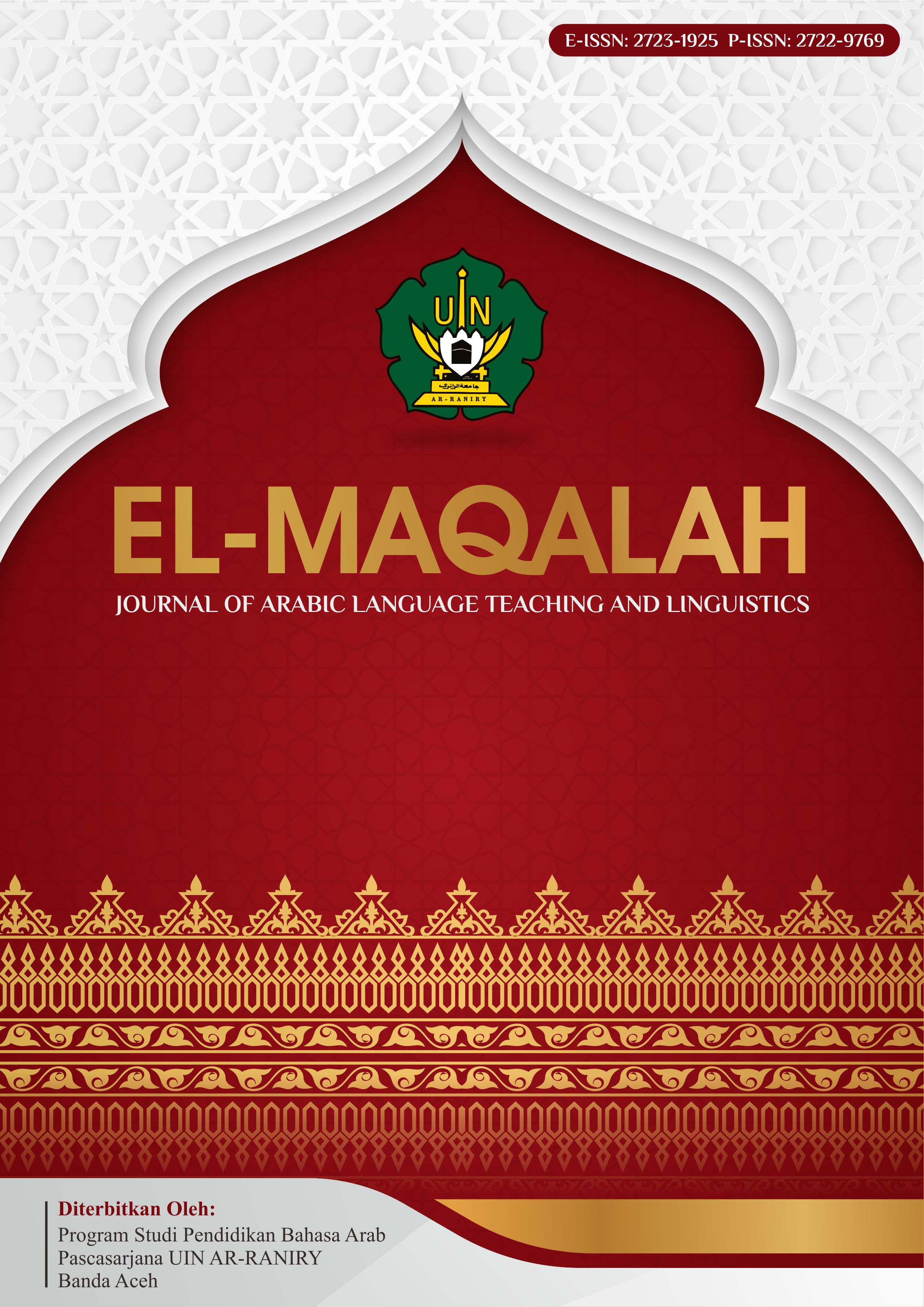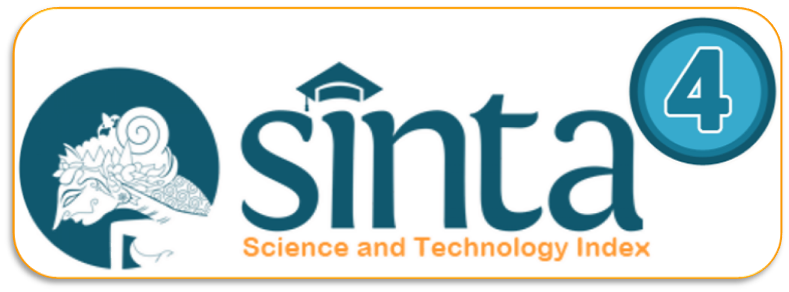Applying Cooperative Learning Using the Number Head Together Method in Teaching Balaghah
في تدريس البلاغة بمعهد دار العلوم العصري بندا أتشيه Number Head Together تطبيق مدخل التعلم التعاوني بأسلوب
DOI:
https://doi.org/10.22373/maqalah.v5i1.4864Keywords:
Cooperative Learning Approach, Numbered Head Together Model, Balaghah LearningAbstract
Based on initial observations made by researcher at Dayah Modern Darul Ulum Banda Aceh, researcher found that students consider Balaghah as one of the most difficult subjects, and most students do not master a lot of vocabulary in the book, and this makes students feel bored and do not want to learn it so that the material is not well understood. This study aims to determine the effectiveness of the application of cooperative learning approach with Numbered Head Together model to improve students' ability to understand Balaghah and to know the activities of teachers and students when applying cooperative learning approach with Numbered Head Together model in teaching Balaghah. The research method used by researchers is the experimental method with the "One Group Pre-Test Post-Test Design" model. The researcher used direct observation, pretest and posttest as data collection methods. The results of this study are: (1) The application of cooperative learning approach in Numbered Head Together method is effective to improve students' ability to understand Balaghah. Because researchers obtained the results of the Wilcoxon Sigh Rank test showing that the results of the significance level Asymp. Sig. (2-tailed) < 0.001 which is smaller than the result of the significance level (Sig) 0.05. This indicates that the alternative hypothesis (Ha) is acceptable and the null hypothesis (H0) is rejected. (2) The activity of teacher and students in applying cooperative learning approach with Numbered Head Together model in teaching Balaghah is very good. The researcher obtained a value of P=90% for the observation of teacher and student activities. The value is in the range of 81 and 100% and this result shows that the activities of teachers and students during teaching and learning are very good.
References
بومنجل، عبد الملك. تأصيل البلاغة، سطيف: جامعة محمد ليمن دباغين، 2015م
الجارم، علي ومصطفى أمين، البلاغة الواضحة، (مصر: دار المعارف)، ص. 8
جامعة الإمام محمد بن سعود الإسلامية. البلاغة والنقد، الرياض: الجامعة، 1994هـ18
مهفر، شيده. أهمية اللغة العربية وعلاقتها بالدين الإسلامي، المؤتمر الدولي اللغة العربية وآدابها وتعليمها، الملجد 1، مالنج في 2021م http://prosiding.arab-um.com/index.php/mudalla/article/view/921
نجاة، حسين. طرائق تدريس النحو العربي لدى طلبة اللغة العربية وآدابها، أقلام الهند، اطّلع عليه بتاريخ 6-2-2023
A’ la, Quantum Teaching. Jogjakarta: Diva Press, 2010
Affandi, Muhammad, dkk. Model dan Metode Pembelajaran di Sekolah, Semarang: UNISSULA, 2013
Buhori Muslim dan Nurul Azila, Tathbiq Madkhal at Ta’allum at Ta’awuni bi Uslub al Istiqsha al Jama’i Litarqiyah Qudrah ath Thalibat ‘ala Fahmi al Maqru bi Ma’had Jeumala Amal Pidie Jaya, Jurnal Lisanuna, Vol. 7, no. 1 (2017) https://jurnal.ar-raniry.ac.id/index.php/lisanuna/article/view/1964/146
Djamarah, Syaiful Bahri dan Aswan Zain, Strategi Belajar Mengajar, Jakarta: Rineka Cipta, 2006
Huda, Miftahul. Cooperative Learning: Metode, taktik, Struktur dan Model Penerapan, Cet.IV; Yogyakarta: Pustaka Pelajar, 2017
Isjoni. Cooperative Learning: Efektivitas Pembelajaran Kelompok, Cet. II; Bandung: Alfabeta, 2009
Jafar, Leonardus. Student Teams Achievement Division (Konsep dan Penerapannya untuk Meningkatkan Hasil Belajar), Jawa Tengah: Amerta Media, 2023
Komalasari, Kokom. Pembelajaran Kontekstual (Konsep dan Aplikasi), Bandung: Refika Aditama, 2010
Octavia, Shilphy A. Model-Model Pembelajaran, Yogyakarta: CV Budi Utama, 2020
Prayitno, Anggar Titis, dkk, Strategi, Pendekatan, & Model Pembelajaran Cooperative Learning dalam Pembelajaran Matematika, Sukabumi: CV Jejak, 2022
Rahmaini, Agustia dan Syarifuddin, Taṭwīr Ta`līm al-Qirā‘ah Bi Ṭarīqah Wadhīfah al-Majmū`ah `Alā Asās al-Madkhal al-Ittiṡālī Wa Ṭarīqah at-Ta`allum at-Ta`āwunī Bi MTsN 1 Aceh Barat, EL-MAQALAH: Journal of Arabic Language Teaching and Linguistic, 4 (2) https://doi.org/10.22373/maqalah.v4i2.3820
Rahmawati, Nur Indah dan Sugeng Sutiarso. Pembelajaran kooperatif sebagai Model Efektif untuk Mengembangkan Interaksi Komunikasi antara Guru dan Peserta Didik, Jurnal Eksponen, Vol. 9 No. 2 (September, 2019) https://doi.org/10.47637/eksponen.v9i2.55
Salim, Latifah. Peranan Bahasa Arab terhadap Ilmu Pengetahuan, Jurnal Adabiyah, Vol. 15, No. 2, 2015 https://journal.uin-alauddin.ac.id/index.php/adabiyah/article/view/701
Slavin, Robert E. Cooperative Learning: Teori, Riset dan Praktik, Bandung: Nusa Media, 2005
Suyono dan Hariyanto. Belajar dan Pembelajaran, Bandung: PT Remaja Rosdakarya, 2011
Widiaswiro, Erwin. Cerdas Pengelolaan Kelas, Yogyakarta: DIVA Press, 2018
Winarmi, Endang Widi. Teori dan Praktik Penelitian Kuantitatif, Kualitatif, PTK, R&D, Jakarta: Bumi Aksara, 2018





























